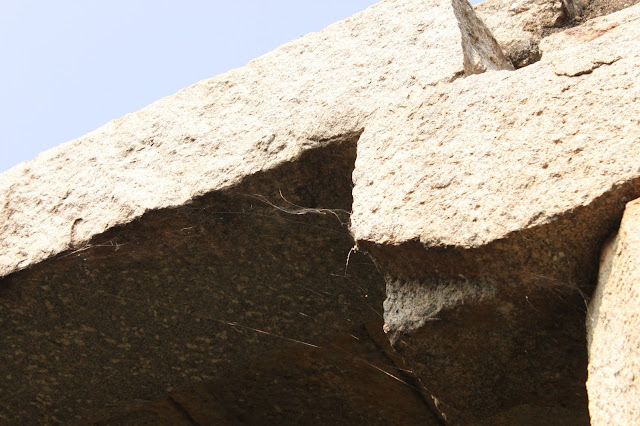Between the 'Sacred Centre' and the 'Royal Centre' areas are located two huge, interesting, monolithic works or art.
The Badavalinga is a Shiva Lingam that is about three metres tall. The Lingam has been chiselled out from a single piece of rock. Three eyes are clearly visible, representing the three eyes of Lord Shiva.
The bottom portion of the Shiva Lingam is permanently in water. The water flows via underground channels that had been constructed during the days of the Vijayanagar Empire. In fact, the Empire was known for having developed an extensive irrigation system built around around the Tungabhadra River and Reservoirs. Incredibly enough, the Reservoirs are still in use today.
The Lakshmi Narasimha Temple is right next door to the Badavalinga Temple. It houses a monolithic statue.
'Ugra' translates to 'terrifying', while 'Narasimha' is the mythical,half man, half lion beast. Damage is evident, including the face, broken arms and snake canopy.
The statue is huge, really huge, over 6 metres, about 20 feet tall.
A curious rock formation greets you as you travel towards the Royal Enclosure area, known as the 'Akka Thangi Gudda' which translates to 'Elder sister - Younger sister rock. The huge boulders seem to be supporting each other.
The Prasanna Virupaksha Temple located nearby is dedicated to Lord Shiva, and dates back to the 14th Century.
A beautifully sculptured statue of the Bull greets you in the Central hall. The hall is rather dark since much of the the Temple is an 'underground' structure.
There are several sculptured pillars in the main hall. Most of the central areas are under water, fed by the system of underground channels.
While clear water must have flowed 500 or 600 years ago, fed by the underground channels, whatever remains of the disused channels has resulted in the water getting stagnant.
Cobwebs seem to add to the decor.

The water channel system is visible outside the main Temple.
The design is extensive, with many passages and small chambers for dieties to be placed at different spots within the temple complex.
Sculptured stones that once were part of the ceremonies now lie scattered and damaged.

The roof of the Temple is at the same level as the ground around one side of the site. This is the main entrance, and exit.
You may be interested in:
-=-=














No comments:
Post a Comment
Your comments...